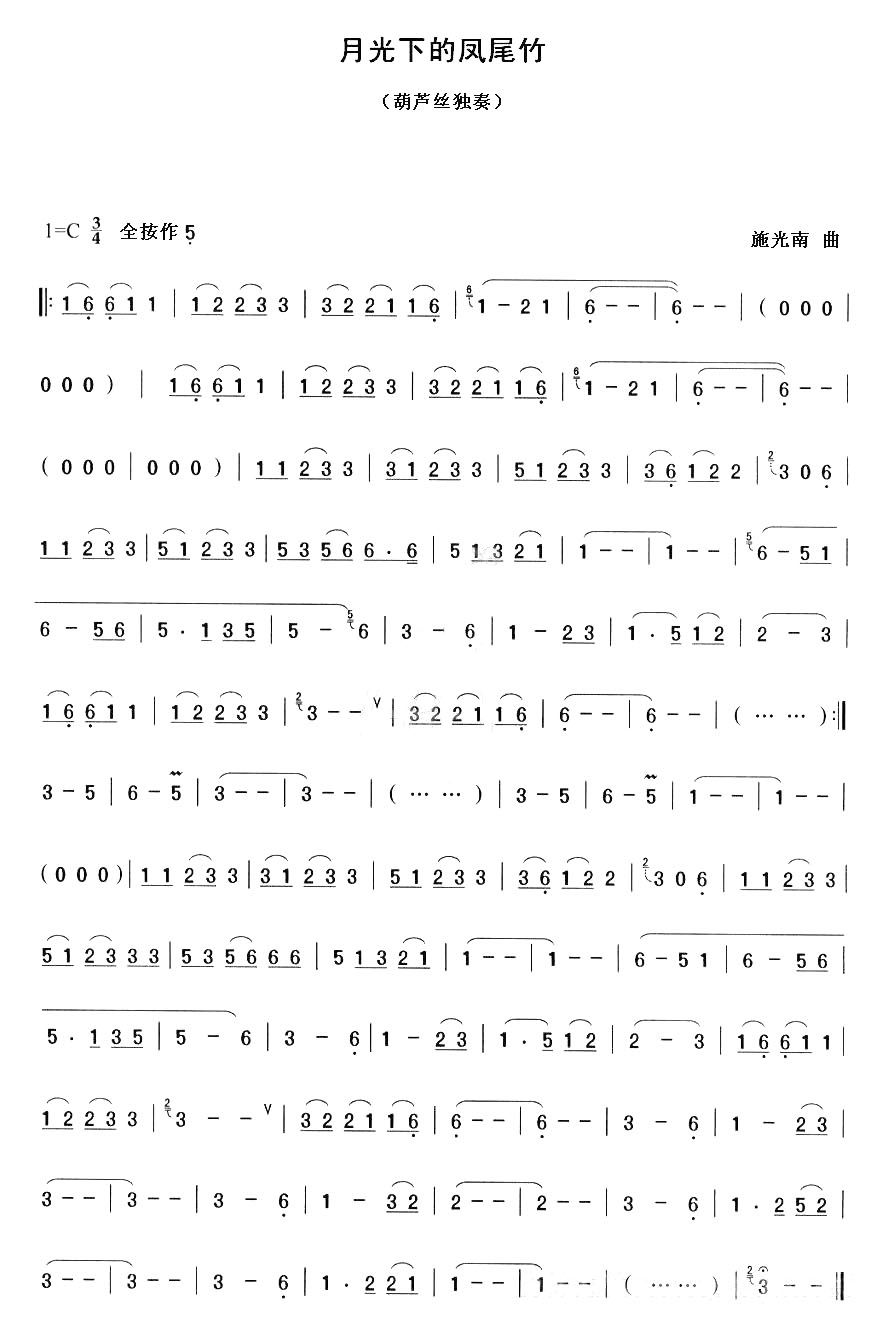Explanation of performance skills of the famous cucurbit flute "Phoenix-tailed Bamboo in the Moonlight"
"Phoenix-tailed Bamboo under the Moonlight" is adapted from the song of the same name written by the famous Chinese composer Shi Guangnan. The 叏 version only deduces the main part of the song, and the chorus part of the second stanza of the song is not involved, but the advantage is that it can be done with a cucurbit flute and one fingering from the beginning to the end, so there are more people playing, Most of what we hear is a joke. The Li version relatively completely reproduces the whole picture of the original song, but it must be completed with two cucurbits and different fingerings, which increases the difficulty.

This piece is a primary piece in the cucurbit solo piece. It is not very difficult, and no complicated performance skills are added. The performance skills in the whole piece include portamento, percussion, duplication and virtual finger tremolo. Basic performance skills. The specific application of these basic skills is clearly marked on the score. As long as you master these skills and control the breath, you can play it more beautifully. Most beginners can play it relatively quickly. Master the essentials of playing this piece.
Although the playing skills of this song are not difficult, it takes a lot of work to really play it well. For example, the portamento should be soft, the transition should be smooth, and there should be no obvious disconnection marks; the hitting should be elastic and jumpy, and it should not be played like an appoggi. The sound should be strong, and the sound should be elastic; the overlapping sound should be crisp and not sloppy; the virtual finger tremolo should have a floating feeling, but it should not be too exaggerated, and it should be superficial. These all require the player to constantly and carefully ponder.
I think there are two solutions:
The first is to solve the problem by transposition, so that one piece of cucurbit flute can play the whole piece, that is, the first part of the simplified tone is played as 5; The first 55 is equal to the last 1, that is, the pitch of the 5th in the first half and the 1st in the second half are the same, so the effect is not very good.
The second is to keep the key unchanged and ensure the integrity and fluency of the music. Only by replacing the cucurbit silk, in this way, the timbre before and after the playback will be different, such as the combination of minor D and major G, or C and major F, bB and bE, there is a problem of different timbres, but this way of playing , no need to change the key, the overall sense and fluency of the music will be more ideal than the first method. I am talking about two cucurbits, two flavors, a sense of role change, and a sense of male and female duet.
So when I play, I advocate the second method.
The performance skills of this song are very easy to master. Common skills include portamento, doubling, and virtual finger vibrato. You can imitate the performance by listening to the demo song several times.
For beginners, you need to do the following:
1. Figure out the fingering. Which sound corresponds to each hole. The fingering of cucurbit silk is relatively simple, I believe you can get it done soon.
2. Well, listen to other people's performance several times and listen to the intonation, so that when you blow it out, you can know which sound is inaccurate and can be corrected.
3. Practice little by little according to the score. In fact, this piece is very simple.
As for this piece, based on my personal practice experience, the following points need to be noted and practiced:
1. Portamento.
In the performance of Hulusi and Bawu, portamento plays a major role in the transition of tone and tone. It is indispensable to achieve a round, beautiful, smooth and rich national style, especially the application of portamento in the performance of Dai style music. Portamento can be divided into portamento and portamento. The portamento finger changes from direct lift to swipe lift, and from direct closing to gradually closing.
For example, in the first sentence of 16611 (6 is the bass, special attention should be paid to the portamento), when you blow 1, the bottom three holes are to be loosened, but when you slide from 1 to 6 (bass), the bottom two holes The upper finger should be applied slowly to the hole like an arc, and try to make the feeling of the finger sliding towards the blow hole.
2. Hit the sound.
The last 1 of 16611 in the first sentence is made as a sound as much as possible, and use your fingers to hit the second three holes at the same time.
3. Personally, I think the most important thing about this piece is the glissando, the punching and the spit.
4. In fact, the most convenient way to say so much is to listen to the music more. In fact, the fingering and playing skills are very troublesome and difficult to understand. When listening to the music to cultivate the sense of music, what skills should be used to play naturally come out. Moreover, the ultimate purpose of playing a piece of music is to obtain a sense of beauty and improve one's musical accomplishment and temperament, so it is even more important to cultivate a sense of music.
Finally, I have a suggestion for you: search for the video of Zoidquan playing and then watch the music score and practice it line by line. This piece is very simple, I hope you succeed soon. If the time is not so tight in the future, you can practice the fingering and blowing well.

 渝公网安备 50010702504639号
渝公网安备 50010702504639号